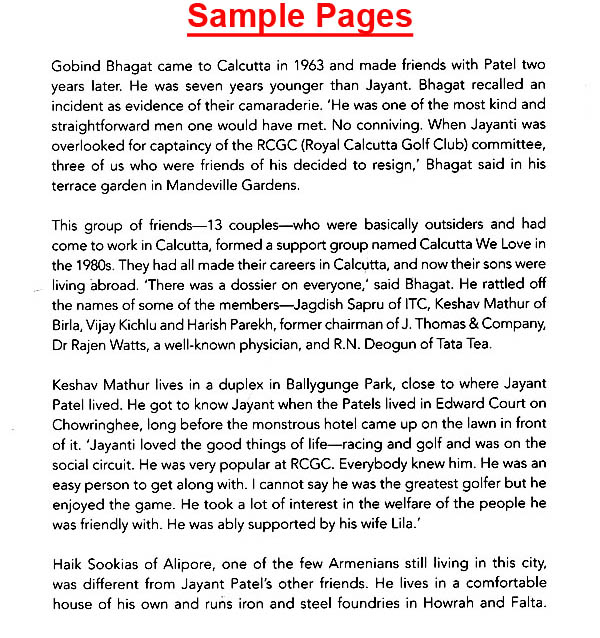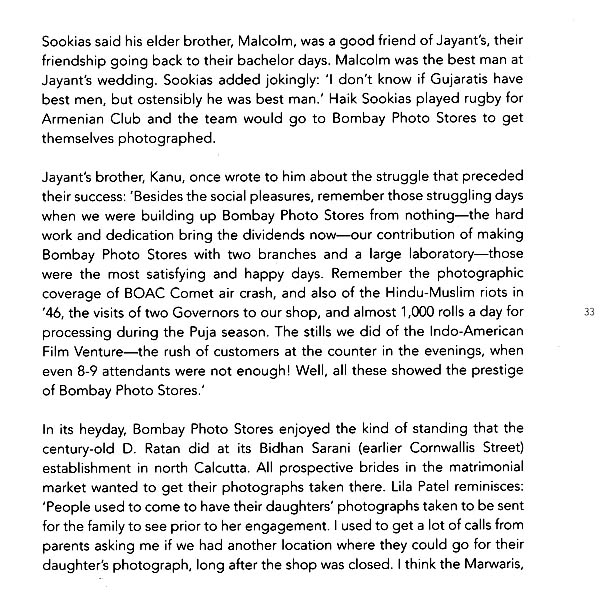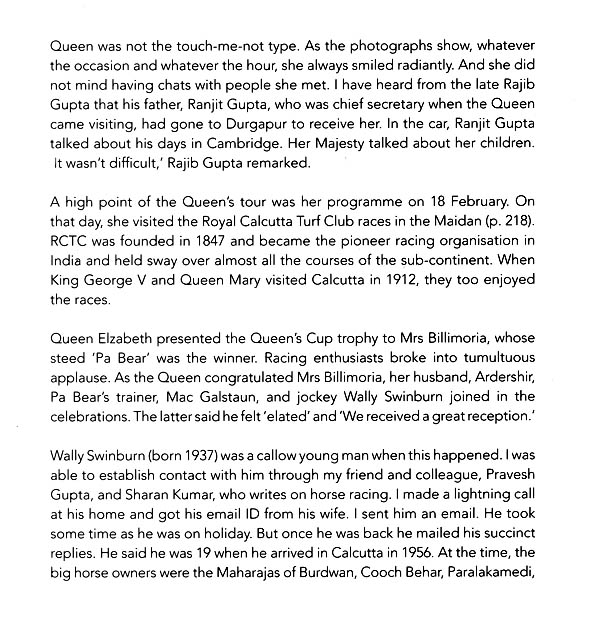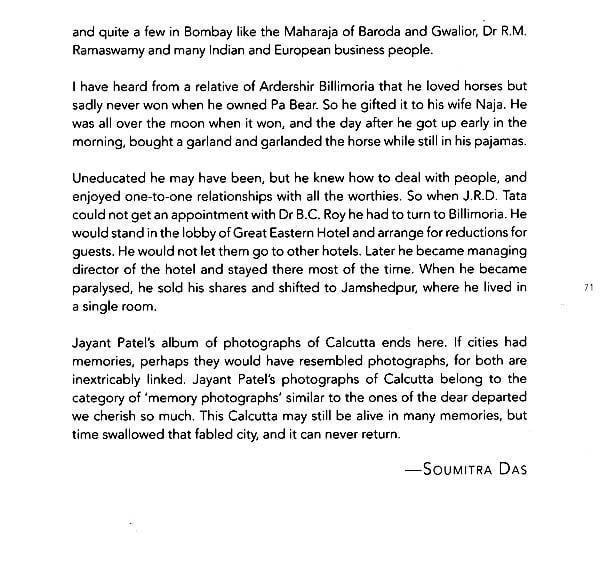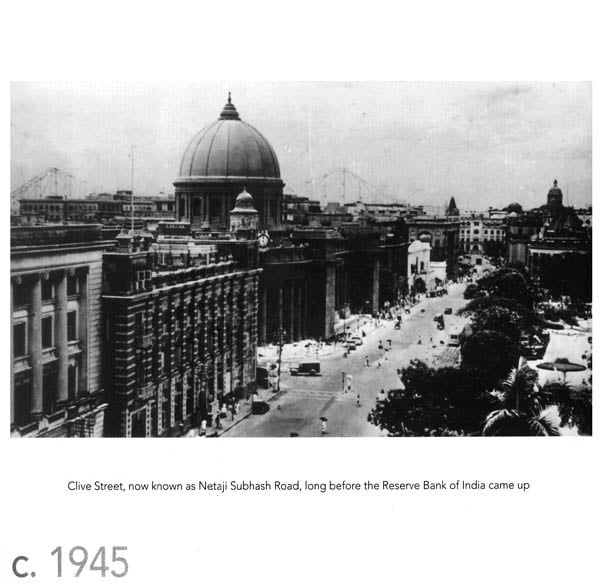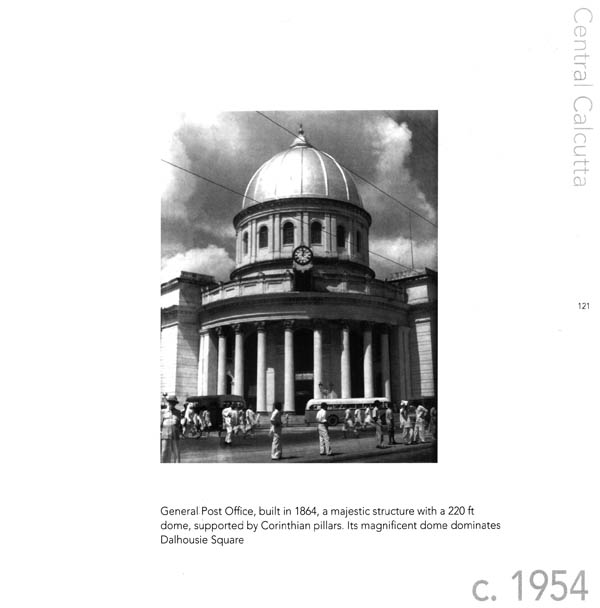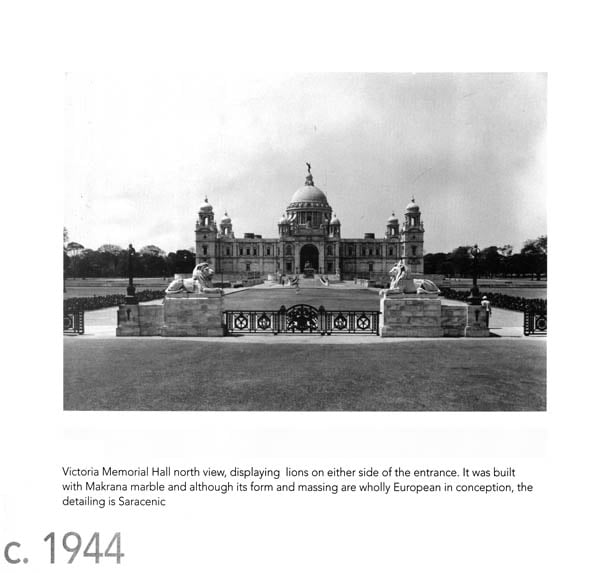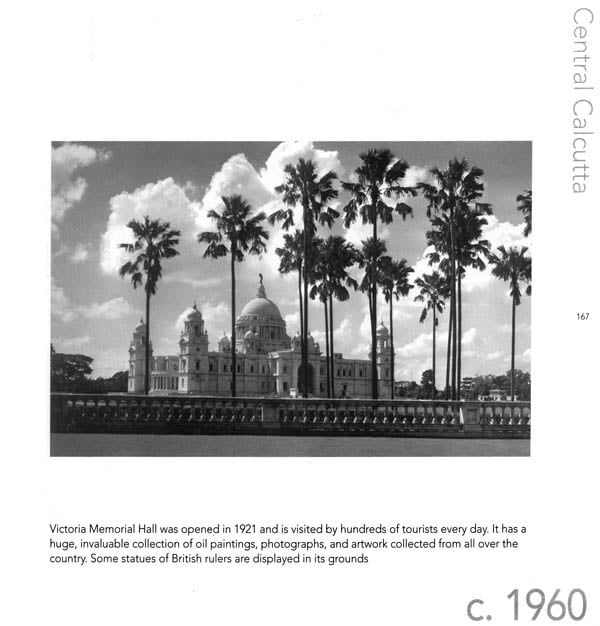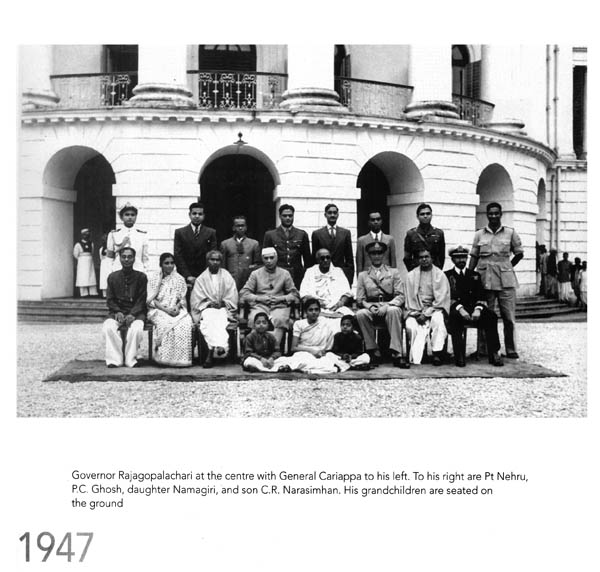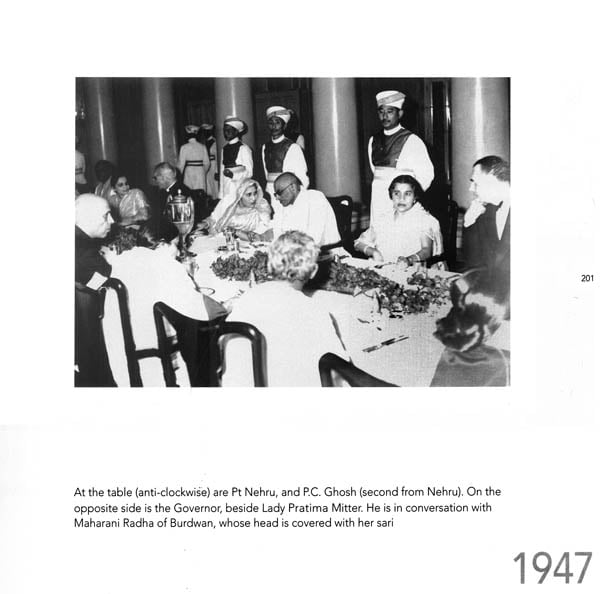
Calcutta 1940-1970 (In the Photographs of Jayant Patel)
Book Specification
| Item Code: | NAN825 |
| Author: | Lila Patel and Soumitra Das |
| Publisher: | Niyogi Books |
| Language: | English |
| Edition: | 2017 |
| ISBN: | 9789386906021 |
| Pages: | 223 (Throughout B/W Illustrations) |
| Cover: | Hardcover |
| Other Details | 9.0 inch X 9.0 inch |
| Weight | 900 gm |
Book Description
Calcutta 1940-1970: In the photographs of Jayant Patel is an outstanding collection of black-and-white photographs, depicting a wide swathe of the city and its various neighbourhoods.
These photographs go back to the glory days of Bombay Photo Stores when it was a prominent landmark of Park Street. As the official photographer of Government House, today's Raj Bhavan, Pate I documented history in the making.
This collection presents glimpses of political life before and after the Partition of a Calcutta that was once the Second City of the Empire.
Lila Patel, born in Gujarat, grew up in Colombo, Sri Lanka and then in Delhi where she graduated from Lady Irwin College. Lila was a competitive golfer and an entrepreneur. She founded the Flora International, later Flora Enterprise, which supplied live plants and flower arrangements to the corporate world in Calcutta till about 2007.
Soumitra Das is a journalist born and raised in Calcutta. He is deeply involved with the visual arts and heritage issues and writes regularly on these topics. He has collaborated with English photographer Christopher Taylor on a book on Dalhousie Square entitled White & Black: Journey to the Centre of Imperial Calcutta. He has also written a history of the Indian Museum and a walking guide to the streets of Calcutta.
It was his mind's ink, made to play with the white of the ambient light.
'No camera, no picture' is of course the plain fact. But it is when the camera is wielded by the artist's mind that we get photographs that are art. The rest are photographs, interesting and important, no doubt, but still not quite 'art'. And when the art of photography has as its subject the making of history, that art also becomes visual historiography.
Every moment in time is material for history of one kind or another. While some periods may see things of uncommon significance happen dramatically, others may pass without a fuss and yet become game changing.
The photographs offered in this volume give us a photo-artist's view of Calcutta in the 1940s and 1950s-a period when momentous history was being made in and around it. World War II saw dizzying action in theatres close to the city's east. There were moments when Japan seemed very close to the seaboard near the city, its airfield and its very heart. And then, the Bengal Famine of 1943, bared the ribs of hunger in Bengal as never before, with the city feeling its fangs. In 1946 came riots, manslaughter of unprecedented scale, presaging the strife that escorted Pakistan out of undivided India.
Having been the imperial capital of the British Raj from the end of the 18th century until 1912, Calcutta had its pride, its honour-home to the Brahmo Samaj, to Keshub Chandra Sen, the Tagores, to Sri Ramakrishna and Swami Vivekananda, Calcutta had its self-esteem-nursery to the poetic flashes of Michael Madhusudan Dutt and Toru Dutt, the brilliant truancies of Derozio and his 'circle' and the patriotic fervours of Aurobindo Ghose, CR. Das and the Bose brothers, Calcutta had a sense of its place in the civilisational history of India. Its buildings spoke of different ages, discrete communities. They reflected phases, mores, and fashions. And so did the spaces that were not occupied by buildings, empty patches before buildings, roads, maidans, bridges, the land under bridges. These comprised a built heritage, a physical heritage that made Calcutta more than a city-a universe.
But going through the trauma of Partition, with hundreds of thousands leaving for the new East Pakistan, and hundreds of thousands coming into the new West Bengal, that Calcutta became, for a while, what it had never been-a city in transition, in flux, in an existential melt. That state, the state of being made, unmade, of being in some kind of 'shift' was new to Calcutta. Others could go through vestibules of change, Calcutta had been and become what it was, centuries ago. That sense of stability, that strong invulnerability, came under stress in the 1940s.
That silent stress was captured by the great photographer of the Bengal Famine, Sunil Janah, and the incomparable sculptor, Somnath Hore. Their work, in different mediums and yet complementary, chronicled Bengal's and Calcutta's travails with the daring and the compassion that only artists bring. Satyajit Ray's Ashani Sanket drew from Janah and Hore.
Jayant Patel's work belongs to their great ouvre.
A photograph does not comment in words. Captions to photographs are afterthoughts. Photographs comment wordlessly but comment they do. They speak non-verbally, non-vocally. Jayant Patel's black-and-white pictures speak, they describe but they do so non-judgmentally, non-prescriptively. They show buildings in strained repose, roads in tension. They show them ageing with struggle but without complaint, with dignity but without false prestige. Peeling plaster and sagging balconies in Calcutta's buildings have the kind of inevitability to them one associates with superannuation, not imminent demise. Be it Queen Victoria or one of her equestrian Viceroys, the statuary of the Raj, in India's once-imperial capital, bespeaks the grace of resignation. Jayant Patel captures the humour and the pathos behind those statues, which seems to have been abandoned by the departing empire to their fates.
The 'mugshots', as we now call full-face pictures of American Gls, stationed in Calcutta during the war, are a study in human psychology. Each one of them is a 'character', their faces holding great stories. The most striking of these is that of the nurse. Such determination lies in those eyes, and such calm! If Jayant PateI has shown himself a master of the long-shot he has shown himself to be an artist of the human face.
Government House, or Raj Bhavan, the Governor's residence now, and once the palace of the Governor General of India, is a favourite of Jayant Patel's lens. That building is the nerve centre of change. Flux is written all over the photographs of Mahatma Gandhi in conversation with the wartime governor, Casey, in one of that building's gracious sitting rooms. The representative of the King-Emperor seems self-conscious even as the Mahatma sits at ease. I had known that photograph for years, without knowing which cameraman had captured that truly memorable moment. It is good to know the art- picture's authorship (p. 190).
The founder of Pakistan, is captured by the camera looking very tense, very preoccupied (p.192). A Premier of Bengal and future Prime Minister of Pakistan, H.S. Suhrawardy is seen at a swearing-in ceremony looking quizzically at one of his colleagues taking the oath of office (p. 193). He seems to ask with some self-assailing humour: How long is all this going to last?
If I were to choose one picture out of these as my 'favourite', I would choose the one in which Nehru and Patel are standing in a close knot, looking at a document. Nehru is the very picture of trusting optimism, Patel of cautious pragmatism. Nehru seems like he has accepted what he is reading, Patel is giving it a close look. While Nehru trusts, Pate I seeks evidence. While Nehru believes, Patel wants proof (p. 195).
The photographs of Chakravarti Rajagopalachari, the first Governor of West Bengal and the first Prime Minister of India, Jawaharlal Nehru, in that house, are veritable nuggets of history (p. 197-201). CR is happy, Nehru radiant as they pose for photographs. Nehru is bright, beaming and ebullient. He has been wafted by history to the crest of a future India. That is the message these pictures convey. The PM and the Governor have seen their shared struggle reach its destination, if at a huge and guilt-laden cost. Are their smiles too broad, their joys too naive for those plangent times? They are, in a sense.
The picture of the urn in Raj Bhavan holding the slain Mahatma's ashes is a poem if ever a photograph can be one.
Lila Patel has placed us in her debt by nurturing her husband's art and then bringing it out of its rest to public viewing. It is my trust that this book will inspire the aspiring photographer to see technology as an art that records and documents human condition and thereby helps us better understand ourselves and our times.
As Jayant was introducing his favourite city to me, he shared in depth his memorable photographs of Pre-Independence and Post-Independence Calcutta .Through his images I saw in him an artist, a writer, and a poet, who through his creative genius had captured the essence of images with a wide spectrum of subject matters, from photographing dignitaries to historical moments, to a lightning bolt during a monsoon thunderstorm. This was the magic of Jayant's keen eye and artistry expressed through a camera lens.
I would like to share the story behind some of the photographs.
It was the summer of 1969, a very hot and sultry day in April. Everyone in Calcutta was looking forward to a Nor'wester that usually brought rain and cooled the place down. We were dressed to go to a party, and I found that the sky had turned dark and there was a strong wind blowing. The trees were swaying, and there was thunder and lightning. Jayant realised that the thunderstorm would lead to heavy rains within no time! He decided to get his camera out to take some photographs. His eyes were alight with the thought of capturing the lightning. He took a few photographs and then placed his camera near the window, fixed the aperture, opened the shutter and left it there. We went to the party and returned after a few hours. Jayant closed his camera and took out the film for the next day. A few days later he came home and told me he had a surprise for me. I could see the excitement in his eyes as he pulled out the photograph from his briefcase. It was this lovely photograph of the stormy night, with lightning illuminating the swaying trees, Victoria Memorial, St Paul's Cathedral, and Nehru Children's Museum (p. 177).
Another interesting event WAS when he had gone to take photographs of Muhammad Ali Jinnah at the Muslim League meeting held at the Calcutta Maidan. He narrated this story to me much later, on a beautiful evening when we were resting on the steps of Victoria Memorial, after our walk. He was reminiscing the good old days when as a youngster he went to cover important events with his camera. On 16th August, 1946 Jayant had gone to the Calcutta Maidan to take photographs of Jinnah. The joy of being in the right place at the right time, was very important for him. The place was full of people shouting slogans, anxiously awaiting the arrival of Mohammed Ali Jinnah. Jayant found himself being pushed around and was afraid of losing his camera. Holding onto his camera for dear life, he tried to make his way through the crowd to reach a place from where he could capture the historic moment. For over an hour he tried to get near the dais but with no luck. Unexpectedly, the space before him opened up, and suddenly he found that he had a commanding view of the dais. There was a lot of excitement as Jinnah arrived. Once Jinnah started talking, there was complete silence and that is when Jayant's camera went to work (p. 192).
Jayant was the youngest of seven siblings born in Mombasa, Kenya on 28 November 1927. His father had the first, full-fledged photography studio with developing and printing facility in Mombasa, where his wife and sons helped him in the processing of films after school. Jayant's interest in photography goes back to his early childhood when he was gifted with his first Kodak box camera at the tender age of five by his father. His interest increased as he took photographs of his family members, school friends, and the sports and picnics he attended.
By early 1940, the political atmosphere was dramatically changing in India. The Patel family decided to move to Calcutta on 8 February 1942, to help the two older sons, who had opened doors of Bombay Photo Stores on Park Street in 1940 and needed help. Jayant was sent to study in Ahmedabad. Before long the schools were closed due to political instability. As a young 15-year- old teenager, in the midst of the Independence movement, with schools closed, Jayant decided to participate in the freedom marches in Gujarat. He went everywhere with his camera hanging around his neck. After two or three months his eldest brother, Jasbhai, happened to visit Bombay on a business trip and found Jayant participating in the freedom movement. He decided to take him back to Calcutta. With schools closed he was made to help in the business. Initially Jayant rebelled but ultimately decided to join Bombay Photo Stores. He enjoyed travelling with his father in the double-decker bus around the city, standing in the upper deck and taking photographs. Some photographs were turned into picture postcards and sold in the shop.
The Pate Is had the privilege of being the official photographer for the Government House and the American and British military. Jayant was sent to cover these assignments. This gave him the opportunity to be at the right time in the right place when history was being made, during the 40's, 50's and 60's. In his camera lens he captured a lot of historic moments; dignitaries and important personalities like Mahatma Gandhi with Governor Casey and with Chiang Kai-shek; Jinnah on the dais in the Maidan, prior to the Hindu- Muslim riots that took place on 16 August 1946. Time stands still when you look at these images and they take you back to that era...
Over the years, those beautiful statues in the Maidan and around the city have disappeared. They have been replaced by new statues. Today, we are left with just faded memories of those glorious days. Jayant always said, 'A camera never lies-with age, buildings deteriorate, people age, but a photograph brings back to life what has been captured in its lens.' He took photography more as a hobby and captured the passion of day-to-day-life-people on the street, a vendor selling coconuts, a snake charmer, anything that caught his eye. An artist's way of expression is through his brush and colour palette, a sculptor has his clay, while a photographer sees his vision through his camera lens. His love for photography was etched in his psyche from then on and to the very end of his days when he was sequencing his treasure trove of images with events, which now I am working towards sharing with a larger audience.
Besides being an avid photographer, Jayant was a businessman who owned at the prime of his career three studios with a large processing lab known as Bombay Photo Stores, normally referred to as BPS, famous for studio portraits. As I reminisce about the 50 plus years of my life with Jayant, I feel so enriched with all that he shared with me about his love of photography and life. As a proud wife, I wish to share my memories of Jayant as a passionate photographer and a sensitive artist, whose keen eye and camera work have left behind images frozen in time, ever so alive, fresh, and new.
